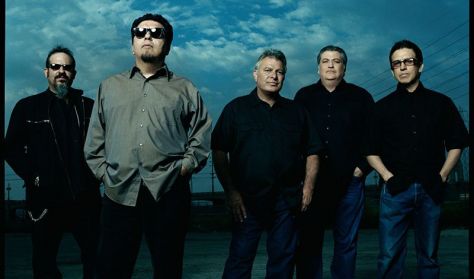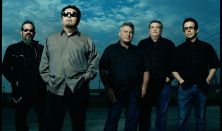Artist

Los Lobos
Los Lobos still are:
Louie Perez- Drums, Guitars, Percussion, Vocals
Steve Berlin- Saxophone, Percussion, Flute, Midsax, Harmonica, Melodica
Cesar Rosas- Vocals, Guitar, Mandolin
Conrad Lozano- Bass, Guitarron, Vocals
David Hidalgo- Vocals, Guitar, Accordion, Percussion, Bass, Keyboards, Melodica, Drums, Violin, Banjo
Enrique "Bugs"…
Current programs
No program is currently running.
Los Lobos still are:
Louie Perez- Drums, Guitars, Percussion, Vocals
Steve Berlin- Saxophone, Percussion, Flute, Midsax, Harmonica, Melodica
Cesar Rosas- Vocals, Guitar, Mandolin
Conrad Lozano- Bass, Guitarron, Vocals
David Hidalgo- Vocals, Guitar, Accordion, Percussion, Bass, Keyboards, Melodica, Drums, Violin, Banjo
Enrique "Bugs" Gonzalez - Drums/Percussion
Los Lobos is unlike any other band, so it’s not surprising that the group’s first-ever Christmas album – Llegó Navidad – would break the holiday-album mold too.
Instead of relying on over-played seasonal standards for its latest album, the band, along with some friends, started out by researching and collecting nearly 150 different traditional (and not-so-traditional) Christmas songs from North, Central and South America. After narrowing down the list to 11 songs – and then adding their own original to the mix – David Hidalgo, Louie Perez, Cesar Rosas, Conrad Lozano and Steve Berlin recorded them on their home turf in East Los Angeles.
The band set out to sing new life into these old songs and make the kind of fresh and vital holiday album that only Los Lobos could make. You’ve probably never heard 10 of the songs (“Arbolito de Navidad” and “Regalo de Reyes”); one you’ve absolutely heard (“Feliz Navidad”); and one you’ve definitely never heard (“Christmas And You”) – which was written especially for the album.
Llegó Navidad opens with Rosas singing “La Rama” (the branch), a lively song played in the regional folk style known as son jarocho, which is popular in the Veracruz region of Mexico. La Rama is also the name of the traditional Mexican holiday custom where the community adorns branches from a tree and displays them in a nightly procession through the neighborhood.
Hidalgo sings lead on “Christmas Time In Texas,” a track made popular by Tex-Mex legend Freddy Fender. Lozano’s distorted upright bass keeps time with his son Jason Lozano on drums, who makes special guest appearance on the song.
“Dónde Está Santa Claus” fires on all cylinders like a lowered Chevy Impala cruising Whittier Boulevard on the weekend. Berlin’s warm Vox Continental organ and Perez’s potent drumming create a head-nodding groove that’s miles away from the 1958 original, which was a novelty hit for 12-year-old singer Augie Rios. His version featured a full orchestra and poppy background vocals.
One of the interesting things about Llegó Navidad is that the rancheras, salsas and son jarochos on the album would sound right at home on the group’s 1978 debut, Los Lobos del Este de Los Angeles. It’s a rare full-circle moment for the Grammy®-winning band, which has prided itself on never covering the same ground twice while making music for nearly 50 years.
Their journey began in 1973, when Hidalgo (vocals, guitar, and pretty much anything with strings), Perez (drums, vocals, guitar), Rosas (vocals, guitar), and Lozano (bass, vocals, guitarrón) earned their stripes playing revved-up versions of Mexican folk music in restaurants and at parties. The band evolved in the 1980s as it tapped into L.A.’s burgeoning punk and college rock scenes. They were soon sharing bills with bands like the Circle Jerks, Public Image Ltd. and the Blasters, whose saxophonist, Steve Berlin, would eventually leave the group to join Los Lobos in 1984.
Early on, Los Lobos enjoyed critical success, winning the Grammy® for Best Mexican-American Performance for “Anselma” from its 1983 EP …And a Time to Dance. A year later, the group released its full-length, major-label debut, How Will the Wolf Survive? Co-produced by Berlin and T Bone Burnett, the album was a college rock sensation that helped Los Lobos tie with Bruce Springsteen as Rolling Stone’s Artist of the Year.
A major turning point came in 1987 with the release of the Ritchie Valens biopic, La Bamba. The quintet’s cover of Valens’ signature song topped the charts in the U.S. and the U.K. Rather than capitalize on that massive commercial success, Los Lobos instead chose to record La Pistola y El Corazón, a tribute to Tejano and Mariachi music that won the 1989 Grammy® for Best Mexican-American Performance.
That kind of sharp artistic turn has become Los Lobos’ trademark, serving to both fuel the band’s creativity and keep its fans engaged. In 1992, that willingness to defy expectations led them to record Kiko, an adventurous album produced by Mitchell Froom that’s considered by many to be one the band’s very best.
Since then, Los Lobos has continued to deliver daring and diverse albums such as Colossal Head (1996), Good Morning Aztlán (2002), The Town and the City (2006), Tin Can Trust (2010) and Gates of Gold (2015). On top of that, the band’s live shows never disappoint, as documented on the recent concert recordings Live at the Fillmore (2005) and Disconnected in New York City (2013). Through the years, they’ve managed to keep things interesting with unexpected side trips like an album of Disney songs in 2009, along with countless contributions to tribute albums and film soundtracks. One of those – “Mariachi Suite” from the 1995 film Desperado ¬– earned the band a Grammy® for Best Pop Instrumental Performance.
Los Lobos has sold millions of records, won prestigious awards and made fans around the world. But perhaps its most lasting impact will be how well its music embodies the idea of America as a cultural melting pot. In it, styles like son jarocho, norteño, Tejano, folk, country, doo-wop, soul, R&B, rock ’n’ roll and punk all come together to create a new sound that’s greater than the sum of its parts.

Los Lobos
MyBoxOffice.US Events- Band
Recommendations
Warning! The basket time limit is about to expire!
item(s) in basket
total:
Time limit has expired. Please, put item(s) in to basket again.

